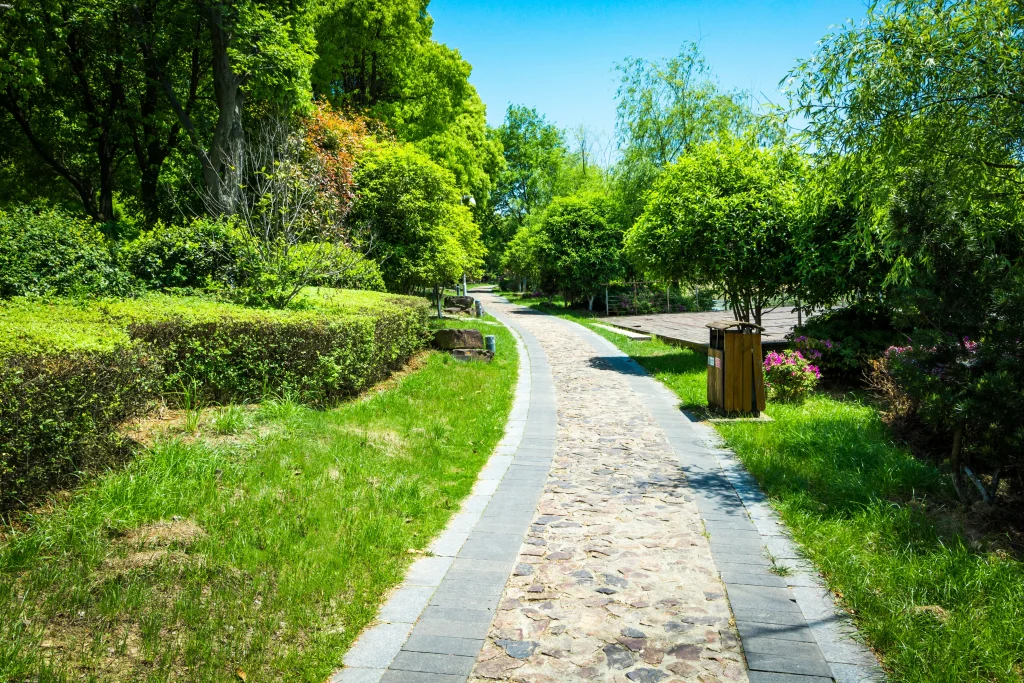If you’ve ever asked yourself “How long should mulch last?”, you’re not alone. Mulch isn’t just about curb appeal, it’s a working layer that breaks down, fades, and shifts over time.
Understanding mulch longevity helps you make smarter decisions about your maintenance schedule, budget effectively for landscape upkeep, and know when to refresh versus fully replace that layer.
Here’s the quick answer: Most organic mulches need a top-up every year and a full refresh every 3–5 years, depending on the type you’ve chosen and your specific growing conditions.
The timeline varies based on several factors we’ll explore, but having this baseline helps you plan ahead rather than scrambling when your beds start looking tired.
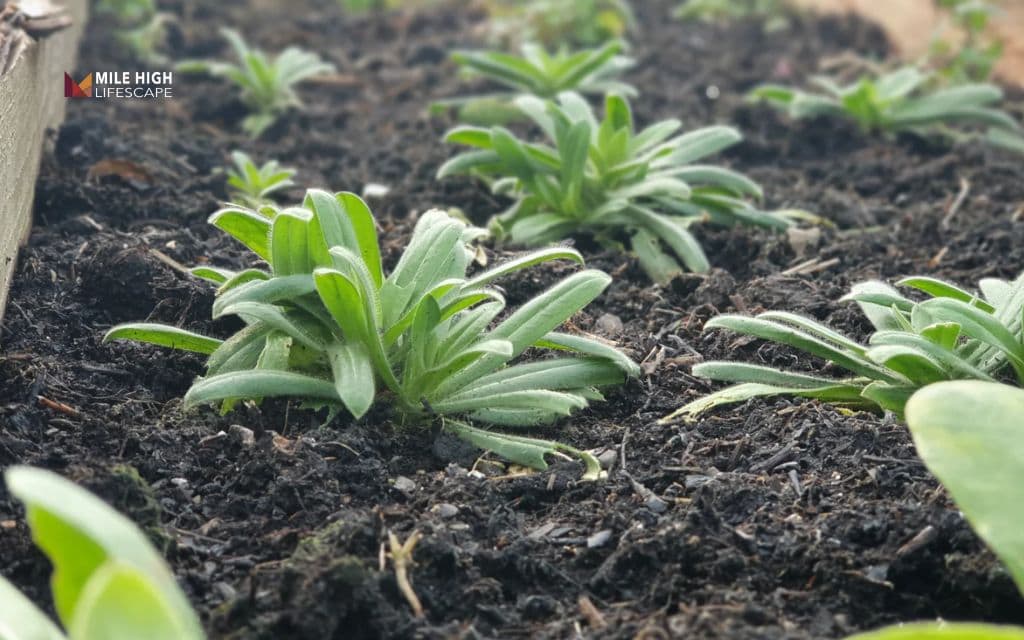
Key factors that affect how long should mulch last in Denver
Mulch material & particle size
Fine shredded mulch decomposes faster than large bark nuggets. The smaller the particle, the quicker it breaks down into soil. This process feeds beneficial organisms but reduces the protective layer your plants need.
Organic mulches release nutrients as they decay. Inorganic materials like rubber or rock remain stable for years. These options don’t feed soil microbes but resist decomposition completely.
Material density matters. Cedar and cypress contain natural oils that slow rot. Standard hardwood bark breaks down at a moderate pace. Leaf mulch and grass clippings vanish within months, serving as seasonal ground cover rather than long-term protection.
Climate & weather
Denver’s elevation brings unique challenges that accelerate mulch breakdown.
- The intense UV radiation causes dyed mulches to fade faster than they would at sea level.
- Our freeze-thaw cycles are equally tough on mulch. When moisture seeps into wood fibers and alternately freezes and thaws throughout winter and early spring, it breaks down the material’s structure.
- Add in our Chinook winds that can literally blow lightweight mulch across your yard, and you’ve got a perfect storm for shortened mulch life.
- The combination of intense sun, low humidity, and temperature swings means mulch simply doesn’t last as long here as it might in more moderate climates.
Bed location & conditions
Where your mulch lives makes a huge difference in how often you’ll replace it. Full-sun beds, especially south- and west-facing exposures, experience the most intense degradation.
High-traffic areas near walkways or where kids and pets play compact mulch faster and kick it out of place. Sloped beds are notorious for mulch migration – gravity and water runoff work together to shift material downhill.
On the flip side, shady, protected beds tucked against north-facing walls or under tree canopies keep mulch intact much longer.
These sheltered spots avoid the worst of our sun exposure and wind, meaning your mulch maintains its color and structure for extended periods. You’ll notice these beds need attention far less frequently than their sun-baked counterparts.
Maintenance practices
How you care for your mulch directly impacts its lifespan. When mulch compacts into a water-repelling crust, it stops doing its job of retaining moisture and suppressing weeds. A quick rake every few months breaks up these mats, improves air and water flow, and helps you get more mileage from your existing material.
Over-mulching is another common mistake that forces earlier replacement. When you keep piling new mulch on top of old without removing or incorporating what’s there, you create deep layers that stay too wet, promote rot, and harbor pests.
How often should you replace mulch?
Shredded hardwood / bark mulch
This is the workhorse of Denver gardens – affordable, effective, and widely available. The functional life of shredded bark mulch typically runs 1 – 3 years, though many landscaping professionals recommend an annual top-up for best appearance and weed control.
Plan for full replacement every 3 – 5 years when the existing layer has become very thin, severely compacted, or broken down into something that looks more like soil than mulch.
Cedar, cypress, and longer-lasting bark
These premium options contain natural oils that resist rot and insect damage, which translates to extended longevity.
Cedar mulch can last 2 – 4 years or even longer before needing complete replacement. The natural resins slow decomposition and help the material maintain its structure despite our harsh climate.
That said, even cedar benefits from annual refreshing for color and depth. While the mulch itself remains functional, its appearance fades just like any other organic material under Denver’s intense sun.
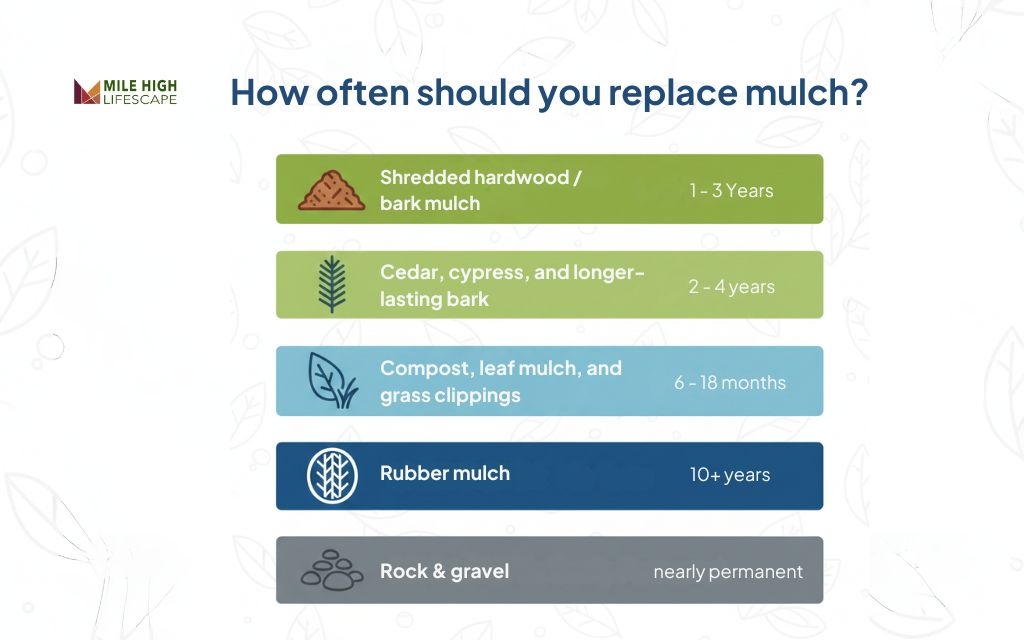
Compost, leaf mulch, and grass clippings
These materials decompose the fastest – typically within 6 – 18 months depending on thickness and how often you water.
This rapid breakdown is actually their purpose; they’re meant to quickly add organic matter and nutrients to your soil. Many gardeners treat these like seasonal mulches that get replenished every spring as part of regular bed preparation.
Grass clippings, in particular, break down so quickly that they’re better thought of as a temporary nitrogen boost rather than a long-term mulch solution. If you’re using these materials, plan on more frequent replacement as part of your ongoing soil improvement strategy rather than expecting the multi-year lifespan of bark products.
Rubber mulch
From a structural standpoint, rubber mulch can last 10 years or more. It doesn’t decompose, compress significantly, or blow away like organic options.
However, even rubber fades under our Colorado sun. The vibrant colors dull over time, and the material can accumulate dirt and organic debris that changes its appearance.
Replacement with rubber is usually aesthetic rather than functional. The mulch still performs its job of suppressing weeds and retaining moisture, but it may not look as fresh as it once did. Some homeowners refresh color with power washing or partial replacement of the most faded areas rather than redoing entire beds.
Rock & gravel
Stone is effectively permanent. However, “permanent” doesn’t mean maintenance-free.
Rocks can sink into the soil over time, requiring top-ups to maintain coverage. Wind and water scatter smaller stones, especially in exposed locations. Leaves, dirt, and organic debris accumulate between the rocks, eventually creating a layer where weeds can establish.
When to replace mulch that’s made of rock usually means adding more material to areas that have thinned out, or occasionally removing accumulated debris and organic matter.
True replacement is rare unless you’re completely changing your landscape design or the stone has become hopelessly mixed with soil.
Signs it’s time to refresh or replace mulch
Here are the key indicators that your mulch needs attention:
Color and appearance issues:
- Heavily faded or bleached color: Dyed mulches that have turned gray or dull have lost their aesthetic value and may be breaking down.
- Patchy, thin coverage: When you can see bare soil showing through in multiple spots.
Performance problems:
- Increased weed growth: More weeds pushing through means your mulch is too thin or degraded to block light and suppress germination.
- Rapid soil drying: If soil feels dry shortly after watering, the mulch is no longer retaining moisture effectively.
- Water runs off instead of soaking in: Compacted mulch that forms a water-repelling crust prevents proper irrigation and needs immediate fluffing or replacement.
Decomposition and health concerns:
- Soil-like texture: When mulch looks crumbly and fine like compost, it’s done its job enriching the soil but no longer functions as mulch.
- Mold, mushrooms, or foul odor: These indicate excessive moisture and anaerobic conditions, requiring removal rather than simple top-up.
- Depth below 2 inches: Mulch thinner than 2 inches won’t provide adequate weed suppression, moisture retention, or temperature moderation.
If you notice 3 or more of these signs in a bed, it’s time for action – either a substantial top-up or complete replacement depending on severity.
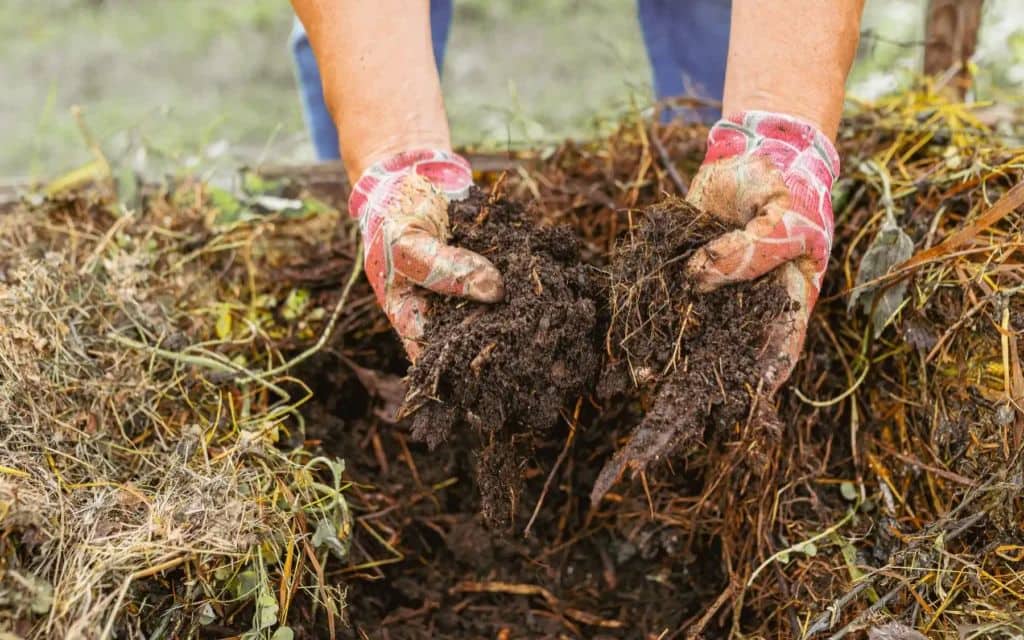
How often should you mulch or re-mulch?
Annual “refresh” schedule
Check your beds every spring – typically in April or early May when you’re doing other garden prep work. Rake existing mulch to break up any crusted layers, assess the depth, and add 1 – 2 inches if the total depth has fallen below the ideal 2 – 3 inch range..
Full replacement timeline
Most organic bark and wood mulches need complete replacement every 3 – 5 years, though you might need to do it sooner if the mulch becomes severely matted, diseased, or you’re dealing with persistent pest problems. By “full replacement,” we mean removing or thoroughly incorporating the old material rather than just piling new mulch on top.
Extend mulch life: Maintenance strategies for gardeners
Maintain the right depth
The magic number for organic mulch is 2 – 3 inches.
Too thin, and you lose the benefits of weed suppression, moisture retention, and temperature moderation. Too thick, and you risk problems with rot, pest habitat, and poor air circulation that can damage plant roots and crowns.
This depth applies after the mulch settles – freshly spread mulch will compact somewhat over the first few weeks.
Fluff, rake, and break up mats
Light raking a couple of times per growing season pays dividends in extended mulch life.
This simple maintenance breaks up crusted surface layers that form when fine particles settle and compact. Fluffing allows air and water to penetrate rather than running off, and it mixes fresher material from below with weathered surface mulch to even out appearance.
Spring is an obvious time for this task, but consider mid-summer fluffing as well, especially after periods of heavy rain that can compact mulch. A few minutes with a rake can add months to your mulch’s effective lifespan by preventing that water-repelling mat from forming.
Top up instead of stripping every year
Current best practices have shifted away from annual complete removal. Most experts suggest topping up existing mulch rather than stripping everything down to bare soil each year.
The old mulch is breaking down and enriching your soil with organic matter – there’s no need to remove it unless you’re dealing with disease, severe pest infestation, or dangerous depths from years of accumulation.
When you add a 1-2 inch fresh layer each spring, you’re essentially creating a mulching system where the bottom layer gradually decomposes while the top layer provides fresh functionality and appearance.
Choose longer-lasting options for high-stress spots
Strategic material selection can reduce your maintenance burden in challenging locations. Consider bark nuggets, rock, or rubber mulch in wind tunnels where lightweight shredded mulch blows away. High-traffic zones near pathways or play areas benefit from more durable materials that won’t scatter or compact as quickly.
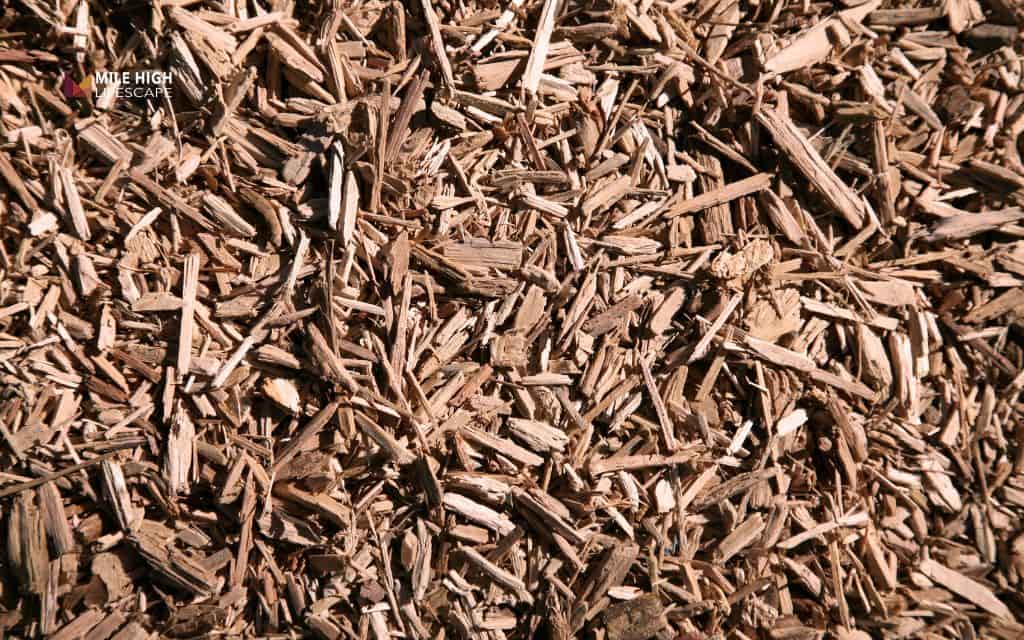
Do you have to replace mulch every year?
Here’s good news: you don’t necessarily need to replace mulch every year.
Many beds simply need a quick assessment, a light raking to break up compaction, and maybe a 1-inch top-up to restore color and depth. This maintenance approach is faster, more affordable, and better for your soil than starting from scratch annually.
The key is making that annual evaluation part of your spring garden routine.
- Walk your beds with a critical eye, checking depth, appearance, and functionality.
- Push aside the surface layer to see what’s happening underneath: Is it breaking down into organic matter that’s enriching your soil, or has it become a slimy, anaerobic mess?
Your observations will tell you whether you need a simple refresh or more intensive intervention.
When full replacement is a good idea:
- If fungal issues, insects, or plant diseases keep returning year after year, old mulch may be harboring pathogens.
- When mulch is piled high against tree trunks or shrub stems, scrape it away completely rather than adding more. This excess causes bark rot and attracts boring insects.
- If accumulated layers have reached 5-6 inches or more, it’s time to thin or reset completely. This excessive depth creates more problems than benefits, including poor air circulation, excess moisture retention, and potential root damage.
Conclusion
Mulch is meant to change over time – that’s actually part of how it benefits your soil and plants. Understanding this natural cycle helps you work with it rather than against it.
For most Denver gardens, the sweet spot involves inspecting and refreshing your mulch every year while planning for a more substantial reset every few years, depending on the type of mulch you’ve chosen and the specific conditions in your beds.
This knowledge helps you protect your plants from temperature extremes and moisture stress, conserve water in our semi-arid climate where every drop counts, and spend your landscaping budget more strategically by knowing when maintenance versus replacement makes sense.
Mile High Lifescape has served Denver Metro for nearly two decades. We provide professional mulch installation service and understand how Colorado’s climate affects landscape materials. Our team can assess your beds, recommend appropriate mulch types, and install them at the correct depth.
Contact us at (303) 877-9091 or hello@milehighlifescape.com for a consultation.
Frequently asked questions (FAQs)
How long should mulch last in Denver’s climate?
Organic mulch lasts 3 – 5 years but needs annual top-ups to maintain appearance and function. Intense UV radiation, freeze-thaw cycles, and wind accelerate decomposition compared to lowland climates. Cedar and cypress last longer than standard hardwood bark. Rock and rubber mulch last 10+ years with minimal maintenance.
How often should you replace mulch in flower beds?
Refresh flower beds each spring with 1–2 inches of new mulch. Complete replacement becomes necessary every 3–5 years when the original material has decomposed into soil-like texture. High-stress beds in full sun may require refresh twice annually. Shaded beds often manage with single annual top-ups.
Do you have to replace mulch every year or just add more?
Add more rather than replace completely. Annual top-ups maintain proper depth as older material decomposes. Full replacement is only necessary when mulch becomes diseased, severely matted, or built up excessively deep from years of layering. Topping up preserves beneficial decomposition happening in lower layers.
How long does cedar mulch last compared to regular bark?
Cedar lasts 2–4 years versus 1–3 years for standard hardwood bark. Natural oils in cedar resist rot and insect damage. However, UV exposure fades both materials at similar rates. Cedar justifies the 30–50% price premium in high-visibility areas or beds that are difficult to access for frequent maintenance.
How often should you mulch around trees and shrubs?
Mulch trees and shrubs annually each spring. Check depth around the drip line and add material to maintain 2–3 inches. Keep mulch 6 inches away from trunks and main stems to prevent rot. Mature trees in low-traffic areas may extend refresh cycles to 18 months if the layer remains adequate.
What’s the difference between replacing and refreshing mulch?
Refreshing adds 1–2 inches of new material on top of existing mulch. This quick process restores color and depth without disturbing lower layers. Replacing removes old material completely before installing fresh mulch. Full replacement requires more time and material but resets beds suffering from disease, excessive buildup, or complete decomposition.
